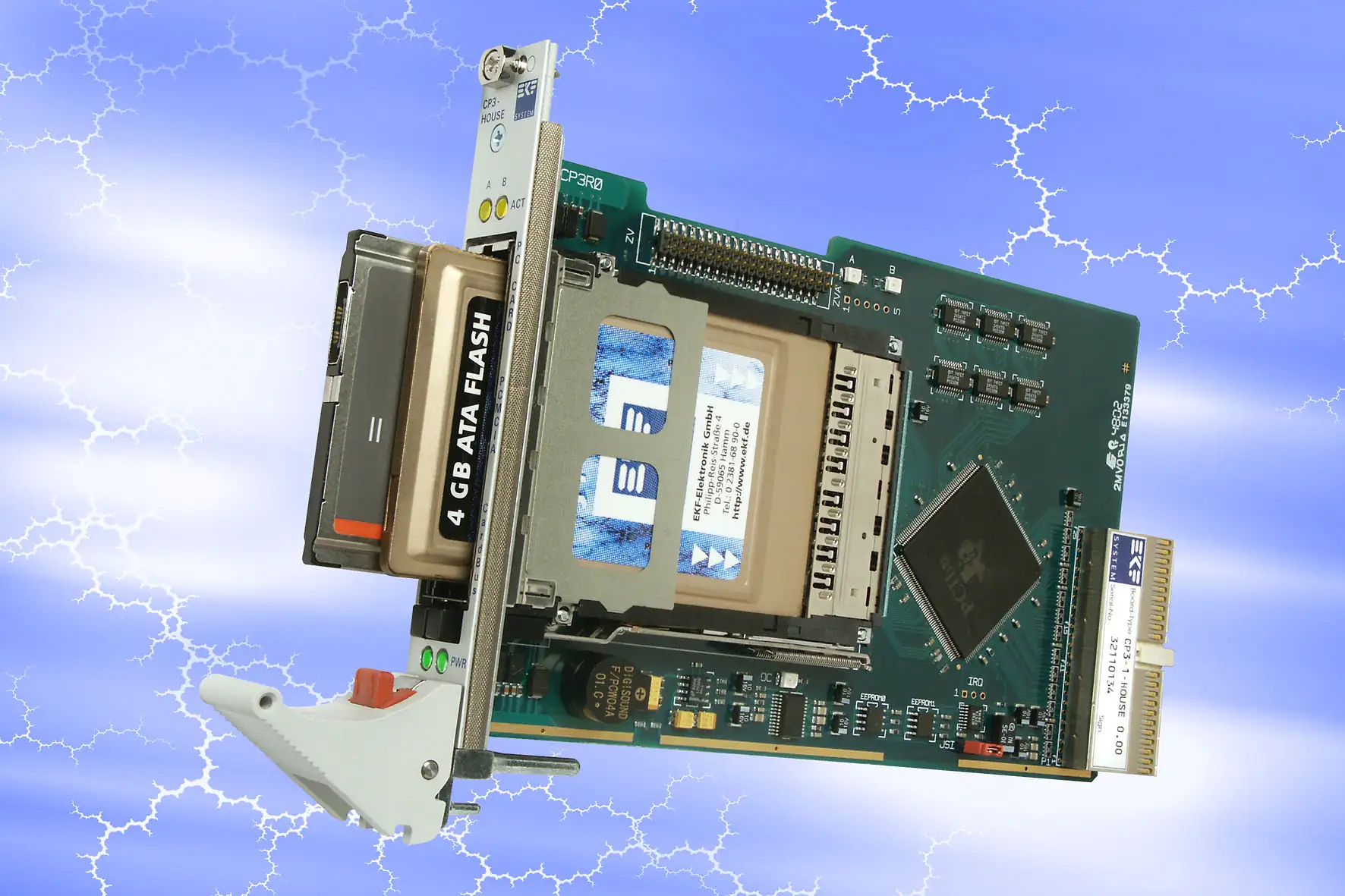CP3-HOUSE
CompactPCI® PC Card Host Adapter – PCMCIA/CardBus Drive
Furthermore PC Cards are widely in use within industrial systems. The CP3-HOUSE is an universal PCMCIA/CardBus™ dual-bay host adapter (PC Card drive) for CompactPCI® systems.
The PC Card™ standard comprises both, the 16-bit version PCMCIA 2.1 (JEIDA 4.2), and the improved 32-bit CardBus™ specification (off PC Card 5.0). By employing a simple adapter, also CompactFlash™ cards can be used.
The CP3-HOUSE supports any combination of 16-bit PCMCIA and 32-bit CardBus PC Cards in its two sockets, automatically powered at 5V or 3.3V, as required. By employing a simple adapter, also CompactFlash cards can be used. Hot swap (hot insertion and removal) of the PC Cards is allowed.
Designed for industrial use, the CP3-HOUSE is a rugged and reliable PC Card drive, suitable for any CompactPCI® system. For usage together with an ExpressCard™, EKF offers a similar host adapter named CP5-GLAM.
The PC Card specification defines three card sizes (3.3/5.0/10.5mm thick), referred to as type I…III. Type I typically can be found with memory cards, and type II with I/O products such as wireless LAN or networking adapters. Type III often will be used with ATA hard disks.
The dual slot of the CP3-HOUSE accepts two PC Cards of the type I/II, or a single type III PC Card.
The PC Card represents a flexible method for external system expansion, without any need to open the case, or power down and reboot the whole system. While the 32-bit CardBus PC Card is equivalent to a modern PCI slot board, the 16-bit PCMCIA PC Card could be loosely compared to a vintage ISA slot board.
The CP3-HOUSE recognizes automatically the PC Card type in use and configures itself for PCMCIA or CardBus operation dynamically. Mix and match operation of 5V/3.3V 16-bit PCMCIA cards and 3.3V CardBus cards is guaranteed. When serving 32-bit PC Cards (CardBus), the CP3-HOUSE acts as a PCI bridge. This allows direct access to the PC Card by the host CPU. Vice versa CardBus cards can become DMA bus masters in order to transfer data at full 133MBps bandwidth across the PCI system bus.
The CP3-HOUSE therefore is well-suited as universal system expansion port, be it I/O function PC Cards, or as an easy way for saving data to a removable memory card or disk drive.
The CP3-HOUSE is equipped with the popular PCI1420 (Texas Instruments) controller chip. Among other features, Hot Insertion and Removal and the Exchangeable Card Architecture (ExCA) are supported by the PCI1420. Both PCI1420 PC Card device drivers, PCMCIA and CardBus, are already integral parts of current Windows operating systems. Slot Vcc and Vpp are controlled by the programmable power switch TPS2224, including over-current protection. Green LEDs in the front panel adjacent to each slot indicate the present slot power status. Yellow LED’s signal the PC Card activity.
In order to use the CP3-HOUSE in 6U systems, a front panel expansion kit is additionally available (CR9-ADAPT).
When older software (legacy drivers) is in use, especially in combination with 16-bit PCMCIA I/O cards (e.g. Modem cards), ISA interrupts may be activated. However, due to restrictions of the CPCI bus specification, the CP3-HOUSE is capable of routing PC Card interrupts to the CompactPCI bus interrupt lines INTA and INTP/INTS only. The CPCI bus does not at all support legacy ISA interrupts (with the exception of the primary/secondary IDE IRQ14/15, which can be optionally processed as INTP/INTS). A solution to this limitation is to transfer serialized ISA interrupts across INTS to the host CPU, which requires that the CPU board can be configured for receiving serial IRQs. ISA service requests typically are caused by legacy software drivers for 16-bit (PCMCIA) I/O PC Cards. When using recent drivers, serialized ISA IRQ jumpering should be superfluous. This also applies for most PCMCIA memory cards, ATA harddisks, and CardBus products.
Due to the huge variety of PC Card products available, often 16-bit (low cost) PCMCIA products, potential conflicts between PC Card application software, the operating system and the system BIOS can arise. In addition, CPCI systems use a PCI bridge to isolate the backplane from the primary (host) PCI bus. Stipulated for CPCI passive backplanes, this is an important improvement in reliability, but not typical for desktop- and notebook-computers. As it appears, this feature remains untested sometimes by the producers of software. However, at least the manufacturers of BIOS software seem to be aware of the emerging role of CPCI systems and PCI bridges, and have eliminated most of the related bugs. If in doubt, use recent software/drivers only and consider a CPU BIOS upgrade.
Optionally, the board is provided with a Zoomed Video (ZV) connector. ZV, as an extension to the PC Card standard, is a fast one-way data path from a ZV card to any ZV compliant display controller. ZV allows for real-time, uninterrupted full frame-rate (live video) display, without charging the PCI system bus or spending CPU calculation time. PCM audio data can be derived from the optional Zoomed Video Audio (ZVA) connector.
PC Cards with built-in audio function, e.g. Modem cards, profit from the optional on-board miniature speaker of the CP3-HOUSE.
Downloads & Ressources
Documents
Specifications
- 3U Eurocard (100x160mm2), front panel width 20.2mm (4HP), mechanics constructed with respect to EMC requirements, ejector lever
Simplified Block Diagram

